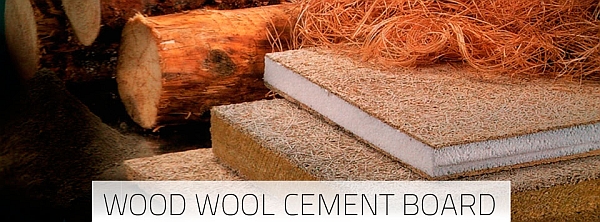Wood wool cement is a cheap and durable panel product for housing produced from mixed indigenous wood species and cement.
The worldwide acceptance of Wood Wool Cement Board proves its versatility and, not least important, its durability in any climatic condition. The main characteristics are:
· Fire resistance
· Wet and dry rot resistance
· Termite and vermin resistance
· Thermal insulation
· Acoustic performance – sound absorption
· Acceptance of a wide range of finishes
The versatility of Wood Wool Cement Board (WWCB) is illustrated by the wide range of applications worldwide. These include:
· Flat and shallow pitch roof decking
· Long span (up to 6 m) roof decking
· Walling for all types of structures
· Thermal insulation
· Acoustic ceilings
· Permanent shuttering of concrete
· Low Cost Housing

Wood Wool Cement Board
Materials:
Giant ipil-ipil
Santol
Mango
Lauan
Cement (Portland or Fortune)
Calcium chloride (technical grade)
Procedure:
1. Curing and debarking
Mixed wood species in log form or slabs, 12-40 cm. in diameter were cut into 40 cm. log billet size and then debarked with a sharp bolo or ax.
2. Shredding
Debarked billets were converted into excelsior of 4 mm. wide and 0.4 mm. thick through the shredder or wood wool-making machine. The shredding of the four wood species resulted in about 90% recovery.
3. Soaking
The excelsior was immediately soaked in water continuously for two days. Water was replaced each day to leach sugar and soluble extractives of the wood.
4. Air-drying
The excelsior was spread out on a cement floor for air-drying. The drying of the soaked excelsior took about one or two days depending on the thickness of the spread.
5. Mixing
The required excelsior, cement and water, and accelerator were weighed properly and mixed thoroughly in a drum mixer for two to three minutes.
6. Mat-forming
After mixing thoroughly, the materials were spread evenly on the 12mm. thick marine plywood caul plates, laid with plastic and formed by placing one caul plate over the other. For 12, 30, and 50 mm. thick boards, 10 and 7 mats were formed per batch of pressing, respectively.
7. Cold pressing and clamping
The mats in a fabricated wood wool were pressed by three hydraulic jacks of 10-ton capacity. Each jack exerted a pressure of about 2 kg./sq. cm. Yakal wood block thickness stoppers were used corresponding to the actual board thickness in between the plywood plates. After pressing to the desired thickness, the whole stack of plates was clamped with bolts.
8. Curing and conditioning
After clamping for at least 24 hours, the wood wool cement boards were piled horizontally with two thickers in between for conditioning for three to four weeks.
Sources: “For Low-cost Housing, try Wood wool cement boards” by Arturo A. Pablo, PCARRD Monitor, Vol. 17, No. 8, Aug. 1989
www.eltomation.com/Eng/wwcb.html
Very interesting